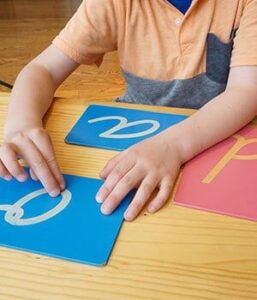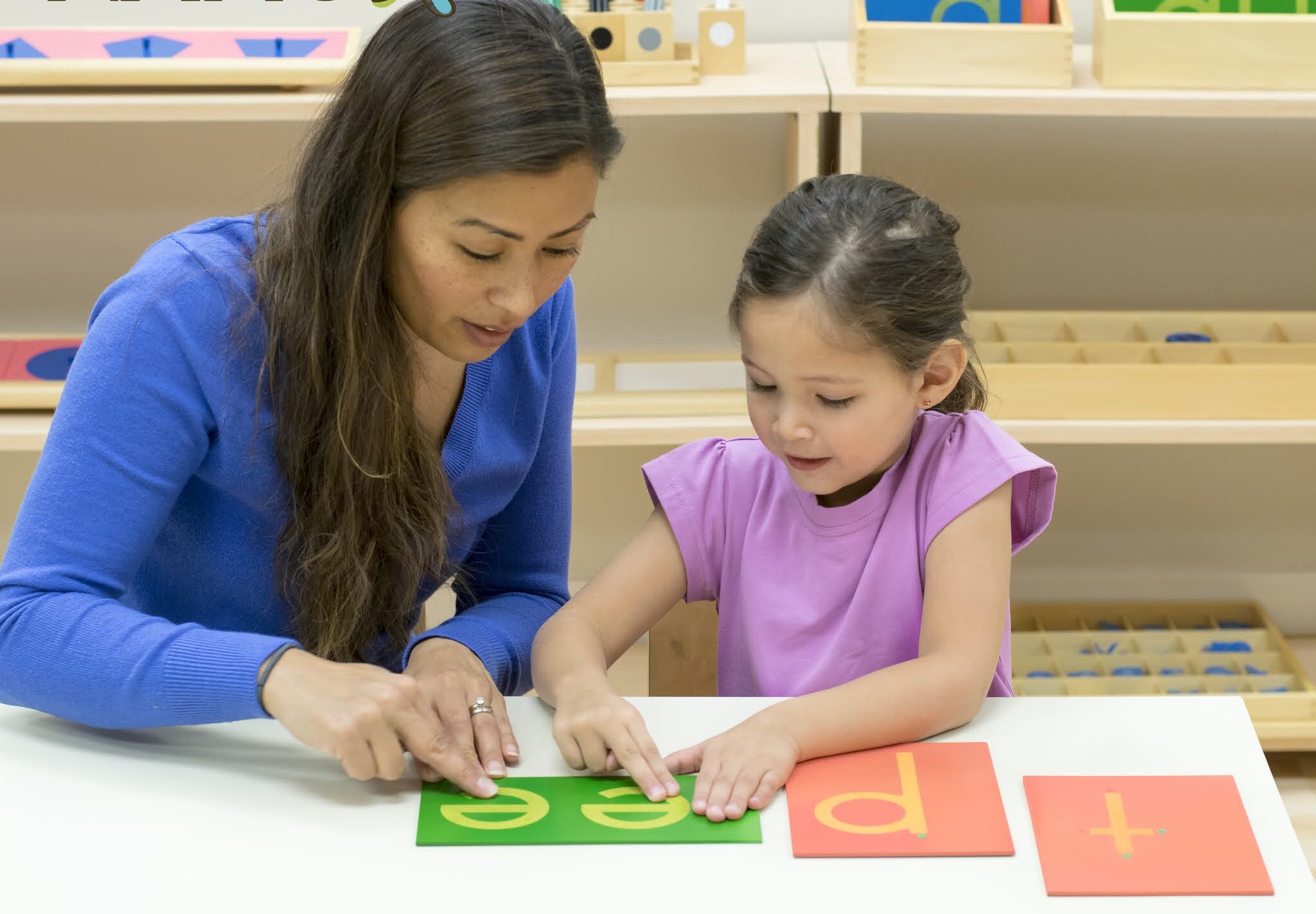“Sandpaper Letters” are a tactile instructional device usually used in Montessori schooling to train children how to write and read. They encompass letters of the alphabet cut out of sandpaper and mounted on cards. Children trace the hard texture of each letter with their palms whilst concurrently pronouncing the letter’s sound, thereby attractive more than one senses—contact, sight, and hearing—to enhance mastering. This multisensory method allows youngsters develop nice motor capabilities and a sturdy foundation in literacy through associating the physical motion of writing with the auditory and visual elements of letters.
SANDPAPER LETTERS
MATERIAL:
Sandpaper Letters: The letters of the alphabet cut out in the finest sandpaper (or the same effect gained commercially by another method) mounted on a strong background. The vowels are mounted on a pale blue card and the consonants on a pale pink background. The letters are mounted with sufficient space on either side to hold them steady. They can be used by either right-handed or left-handed children.
A simple cursive letter is used. The children learn to write simple cursive letters from the beginning. They write the letters separately at first. Later, when ready to join their letters, they can do so without difficulty. At the same time, as these are simple cursive letters, the children will have no difficulty in recognizing the printed letters they will see in books.
PURPOSE:
To learn the sound and shape of the Sandpaper Letters of the alphabet. To gain a muscular memory of the shape of the letters as a prelude to writing.
AGE: 4 and onwards.
BACKGROUND INFORMATION:
With the sandpaper letters the teachers will introduce the phonetic sounds to the child. Centuries ago, the Phoenicians discovered that they could represent each of the sounds of language with a symbol. This was a great discovery since it meant that any word could be represented by a few symbols. No longer would a new symbol have to be invented for every word and idea. Written language would not be such a monumental task of memorization.
Any new word could be figured out because it would be made up of symbols already known. And so, today, anyone who knows how to sound out words can decode any new word they confront. Eighty percent of the time, letters use the phonetic sound. A child who can use this knowledge is far ahead of the child who is taught through a “Look/Say” approach. The child taught through a “Look/Say” approach is limited to the words he has been specifically taught and his ability to remember those words.
Teaching Letter Sounds First in the Montessori Approach.
Sandpaper Letters In the Montessori approach, the sounds of the letters are taught before the child is introduced to the names of the letters. Research has shown that it is best to learn one thing at a time. It is too much to have to remember both names and sounds. If the child is taught both the names and the sounds in the beginning, it has been found that the child gets confused when trying to sound out a word because it is difficult to remember which the letter represents.
Therefore, to avoid the added difficulty, the phonetic sounds of each letter is taught first, and the names of the letters are taught later. In addition, since some letters can represent more than one sound, the other sounds which are less frequently used than the phonetic sound are also taught later. In this way, the child only has to learn one sound for each letter in the beginning.
In addition, since sounds obviously occur in all parts of words, children are led to hear the sounds in the different parts of a word. It is a mistake to think that it is easier for children to listen to or identify just the beginning letter of a word.
But more than this, it is an error to mislead children into thinking that they only have to listen for the first sound. Children need to hear sounds in all parts of a word. Therefore, in the Montessori approach, the children are led to hear how the sounds they are learning occur in different parts of words. With this practice they soon begin to realize the sequence of sounds in words.
The Multi-Sensory Method for Teaching Letter Sounds in Montessori Education
The teaching of the sounds Sandpaper Letters is through a multi-sensory approach. The child will hear the sound, see its representation in the form of a letter, and feel the way it is written as the child feels the letter with his fingers. Since a motor pattern should be learned 
Correctly the first time, it is very important that the child traces properly formed letters. This will help him develop a good pattern for handwriting. Therefore a basic form of the cursive letter is used. In this way, when a child changes his motor pattern by changing from a ball and stick form of letter to a more flowing curvilinear letter, the child will only have to extend the pattern of writing he is already using by adding connecting strokes instead of also having to reform the Sandpaper Letters.
As a result, the only difference for the child between his “print” and his “cursive” writing will be the addition of the connecting strokes to complete the cursive style. So, the letters will be made as follows:
Capital letters will be introduced later. The teacher must be careful not to introduce too much at a time.
SANDPAPER LETTERS – FIRST PERIOD
PRESENTATION :
The child washes her hands in warm water so that they are at normal temperature and sensitive to touch. The letters will also be kept clean. The teacher takes two letters that contrast in shape and sound, e.g., “t” and “s” She sits beside the child.
The three period Lesson is used when presenting the Sandpaper Letters and the summary and is given at one time. In the First Periods, the teacher tells the child the sounds and has the child feel the letter. In the Second Period, the teacher cheeks to see that the child has associated the correct sound with each letter. In the Third period, the teacher asks the child to give the child example i=of the sounds used in different parts of words.
FIRST PERIOD:
Sandpaper Letters The teacher places a letter in front of the child and asks her to watch. The teacher then traces the letter lightly several times, in the direction in which it is written, using the first two fingers of her dominant hand. She repeats the phonetic sound of the letter while feeling it. Next, she gives the letter to the child and asks her to feel it in the same way. While the child feels it, the teacher continues repeating the sound. She does not ask the child to say the sound, but if the child copies her, it is all right. She encourages the child to feel the letter many times.
She makes sure that she traces it in the direction in which it is written. She repeats the process with the second letter. This can be repeated as often as necessary for the child being taught.
SANDPAPER LETTERS – SECOND PERIOD
SECOND PERIOD :
Sandpaper Letters The teacher wants to see if the child has made the connection between the shape and the sound of the letter. She puts both letters in front of the child. She says, “Find the ‘t’ and feel it. 2If the child selects the correct letter, she asks her to feel it a few times and while she does so, the teacher repeats the phonetic sound. This is repeated with each letter as often as necessary.
SANDPAPER LETTERS – THIRD PERIOD
THIRD PERIOD:
The teacher wants to see if the child can pronounce the sounds correctly. She places one letter in front of the child. She asks her to feel the letter and to say the sound. This stage is practice with with both
SUMMARY:
Sandpaper Letters The teacher wants to give the child an idea of how the letters are used in words. She places a letter in front of the child, e.g., “t” , and says, “Listen. Can you hear ‘t’ when I say table, when I say Tom, when I say hot, or in Kitten?” She suggests a number of words containing the sound of “t” The teacher takes the other letter “s” She asks the child to listen for the sound “s” in the words she says. She uses words like sun, snake, hiss, strong, Sally and vest.
She is careful to put the sound in different places in words, not away at the beginning. She finishes the lesson by letting the child know that she, too, can think of words containing the sounds she learned. She says, “If you think of any word with ‘t; or :s; in them, come and tell me.”
NOTE: Sometimes the child has learned the names of the letters before coming to school. In this case, the teacher must explain to him that each letter has a name and a sound. Because he knows the names, she will only have to teach him the sounds. At no time in the lessons does she use both.
